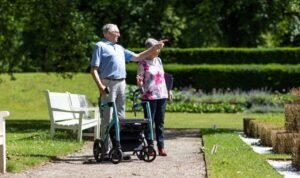
A little greenery does everyone good. In fact, it’s essential for our mental health. This goes double for senior residents: green spaces are good for their physical health (actually reduces the risk of many chronic diseases), and they encourage social interaction while promoting a sense of community.
And you don’t need a large, sprawling park to gain those benefits. A small to medium-sized well-kept garden and nice, green walkways are all it takes. Sure, a big green space is the best (especially if you turn some of it into small garden zones), but no matter the size, the goal is the same: to encourage residents to spend more time outdoors and get clean air while getting some gentle exercise and mingling with others.
But what projects should you start with, and which ones seem to bring the most benefits?
Landscaping Projects That Boost Wellness
Incorporating more greenery is practically always beneficial both for residents and the aesthetic of the home and neighborhood, but here are some priorities to consider if general wellness is the goal.
1. Shade structures and pergolas
To encourage residents to spend more hours outdoors in the summer, add more shade. Choose modular, low-maintenance materials like powder-coated steel or rot-resistant wood alternatives, and position structures to shade benches and walking routes during peak sun.
2. ADA walking loops
Design continuous, low-gradient loops with 36–48 inch clear widths, regular resting benches, and handrails where grades increase. Short loops (200–400 meters) will encourage repeat use and are ideal for balance training and social ambles.
Clear surfacing and tactile cues are also important as they help residents with vision or mobility aids. (This is also the single best intervention to reduce sedentary time among frailer residents.)
3. Raised planters and accessible beds
Raised planters are always a good idea, but especially if you want to encourage some light gardening for people who can’t kneel. They also create visually appealing planting zones and can double as seating edges in small outdoor spaces.
Use shallow, wide beds for wheelchair access and include mixed-height plantings for easy reach.
4. Quiet nooks and flexible seating
Another great way to enhance the look of a large lawn is to break it into smaller, sheltered pockets with movable chairs and small tables. The residents are practically guaranteed to chat longer outside this way, plus, for care and nursing homes, it’s a cost-effective way to make visits with family more pleasant.
You can also add low-visual-barrier hedges to buffer wind and traffic noise without isolating users.
5. Wildlife-friendly gardens
Native plants, pollinator meadows, and small fruiting shrubs both look great and are good for the environment as they invite birds and butterflies. Residents will also enjoy benign wildlife encounters; they boost mood and can spark creativity and curiosity.
Keep maintenance zones trimmed and use signs to explain seasonal rhythms as simple interpretation tends to increase engagement.
6. Low-glare, human-scale lighting
Use low-glare fixtures on short posts, with warm color temperatures and even spacing. Good lighting should extend usable hours and reduce trip risk without creating light pollution. Photocell or timed controls cut energy costs and nighttime glare for residents inside.
7. Non-slip surfaces
Opt for textured pavers, porous asphalt, or rubberized walkways with flush edges at transitions. Proper slope, drainage, and maintenance dramatically lower fall risk, which is an essential concern for senior populations given the rising toll of fall-related injuries and deaths.
Scoping, Pricing, and Phasing
If you’re just starting, this may seem like a huge project. In that case, it’s best to break it into three phases:
- Safety and access (walkways, lighting, non-slip surfacing),
- Comfort and programming (shade, seating, accessible beds),
- Biodiversity and aesthetics (native meadows, seasonal color).
This should simplify things, as well as help you spread capital costs. When you scope and request bids, ask for line-item estimates that separate hardscape, softscape, irrigation, and labor so you have everything laid out.
Dynascape is a software that can help with the entire process as it streamlines design-to-proposal workflows and produce clear, itemized estimates administrators can send to vendors.
Cost-smart tips
- Start with a safety audit: sealing trip hazards and improving lighting yields big risk-reduction returns.
- Use native, drought-tolerant plants to cut irrigation and maintenance.
- Bundle purchases (benches, planters) to get trade discounts.
- Consider phased volunteer or therapy-garden programs to offset ongoing labor costs.
Wellness Benefits vs. Upkeep
All of the projects we’ve outlined provide multiple benefits, including better outdoor aesthetics, social cohesion, shade and cleaner air, and improved physical activity thanks to gardening. That said, they come with routine needs: pruning, seasonal planting, surface repair, and lighting checks. So factor labor hours and irrigation into annual budgets (use realistic hourly rates for your region). For plant-heavy schemes, budget for two years of intensive care to ensure establishment before assuming low maintenance.
Final Note
You want durable improvements that support daily life, not just postcard views. So prioritize access and safety first, then add elements that invite social use and seasonal delight.
If you scope projects with clear, itemized proposals (and a sane maintenance plan), you’ll build outdoor spaces that actually get used, and that’s the whole point. Residents will absolutely notice the difference.